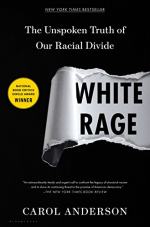|
This section contains 733 words (approx. 2 pages at 400 words per page) |

|
White Rage: The Unspoken Truth of Our Racial Divide Summary & Study Guide Description
White Rage: The Unspoken Truth of Our Racial Divide Summary & Study Guide includes comprehensive information and analysis to help you understand the book. This study guide contains the following sections:
This detailed literature summary also contains Topics for Discussion on White Rage: The Unspoken Truth of Our Racial Divide by Carol Anderson Ph.D..
The following version of this book was used to create this study guide: Anderson, Carol. White Rage: The Unspoken Truth of Our Racial Divide. New York: Bloomsbury, 2016.
White Rage: The Unspoken Truth of Our Racial Divide is a nonfiction book by Carol Anderson, a professor of African American Studies at Emory University. This book examines racism in the United States, with a focus on how white supremacy has shaped American culture, laws, and politics in fundamental and destructive ways. The book’s prologue provides a brief introduction to racism and white rage in America. These dynamics dominate government and media in the United States. These dynamics often function to portray the perpetrators of racial oppression as moral, and the victims of racial oppression as immoral.
Chapter 1 focuses on the Civil War and Reconstruction eras of American history. Although Abraham Lincoln pursued the abolition of slavery, he expressed direct opposition to the idea that black and white people should ever be equal under the law. After Lincoln was assassinated, Andrew Johnson served as President. Johnson was from the South, and pardoned many Confederate leaders. Johnson was complicit in reinstating Confederate leaders in positions of power. These leaders then instated various laws and institutions to essentially re-create conditions of slavery in the South.
Chapter 2 focuses on the Great Migration, which began in the 1910s. Black people in the South began to migrate to the North in large numbers. The South’s economy still relied heavily on exploiting black workers, so the South employed various measures to forcibly prevent black people from migrating. Nonetheless, many black people did successfully migrate. As their numbers grew in the North, white Northerners grew increasingly angry and fearful. White Northerners devised and enacted systems of segregation, and they also perpetrated various large-scale acts of violence against black people. If a black person tried to defend themselves, they were arrested and punished, while the white attackers were not punished.
Chapter 3 focuses on education in America. Public school systems in the United States have generally been segregated by race, with a large majority of funding being directed to predominantly white schools. In the 1950s, multiple Supreme Court decisions ruled that segregation in public schools was unconstitutional, and that schools had to be integrated. In response, many school districts and state governments employed tactics to stall, defy, and undermine integration.
Chapter 4 begins with a brief discussion of the Civil Rights Movement, which secured the passage of the Civil Rights Act and the Voting Rights act, two extremely important pieces of civil rights legislation. In response, in the late 1960s, conservative politicians made efforts to appeal to white Americans’ racist tendencies. Richard Nixon secured the presidency with a campaign that employed subtle tactics that directly appealed to racism. During his time as President, Nixon failed to repeal/weaken the Civil Rights Act and the Voting Rights Act. However, his Supreme Court appointees eventually succeeded in dismantling many key elements of previous rulings that had protected against racial discrimination in education.
Chapter 4 also discusses Ronald Reagan’s presidency, which was disastrous for black Americans. Reagan was first elected in 1980. He drastically reduced social programs designed to help disadvantaged black Americans. Also, as a result of a series of illegal deals later known as the Iran-Contra scandal, Reagan caused large amounts of illegal drugs and weapons to funnel into low-income neighborhoods. Reagan responded to these problems (that he created) by directing law enforcement to focus on arresting black Americans, mostly for nonviolent drug charges. To this day, law enforcement continues to be a major contributor to racial oppression.
Chapter 5 begins with the election of Barack Obama. In response to Obama’s political success, many white Americans exhibited an increase in racist hostility. There has been an increase in police brutality against non-white Americans, as well as an increase terrorist attacks perpetrated by white people against black people. Additionally, in the years since the 2008 election, conservative politicians have passed numerous laws designed to restrict non-white Americans’ ability to vote. In 2013 and 2014, the Supreme Court handed down rulings that upheld these unjust laws. Voter suppression was a key factor in enabling the election of Donald Trump. Anderson ends the book by recounting the ways in which racism has harmed the United States as a whole. She advocates for the dismantling of racial oppression not only for the sake of the oppressed, but also for the oppressors.
Read more from the Study Guide
|
This section contains 733 words (approx. 2 pages at 400 words per page) |

|



